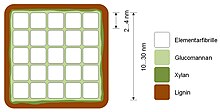Microfibrils
| Parent |
| Cell wall |
| Gene Ontology |
|---|
| QuickGO |
Microfibrils are components of the plant cell wall . Fibrous elements, the macrofibrils (diameter: 0.5 mm), can be seen in the cell wall even with a light microscope . These are made up of interwoven microfibrils (diameter: 10–30 nm). Microfibrils are in turn made up of up to 20 smaller units, the so-called micellar strands or elementary fibrils (diameter: 2-4 nm), which are embedded in an intercellular substance made of hemicellulose ( glucomannans , xylans ) and lignin .
Elementary fibrils are made up of up to 50 cellulose threads . These cellulose threads are arranged in parallel, but each shifted by half a glucose molecule , so that hydrogen bonds can form between the individual strands.
In plant cells, the primary cell wall , which is formed first, consists of cellulose microfibrils that are criss-crossed (scattered texture) and connected by hydrogen bonds . As soon as the cell has reached its maximum size, a second cell wall (secondary wall) is created underneath. In contrast to the primary cell wall, the microfibrils are arranged in parallel here (parallel texture), and their direction changes slightly with each new layer. This guarantees the stability of the cell or the whole plant.
The swelling of wood is, among other things by the storage of water - molecules caused between fibrils, said bridges are broken between the fiber wall components.
Individual evidence
- ↑ M. Rosenthal, E. Bäucker: The cell wall construction of coniferous tracheids . 2012.
- ↑ Helmut Moll, Karl-Eugen Maulbetsch: Abitur-Training Chemie 2. Stark Verlagsgesellschaft, 2005, ISBN 3-89449-130-2 .
- ↑ Elmar W. Weiler, Lutz Nover: General and molecular botany. Thieme, Stuttgart et al. 2008, ISBN 978-3-13-147661-6 , p. 94.
